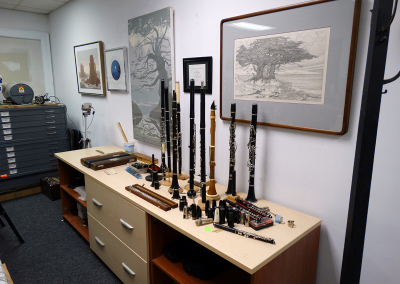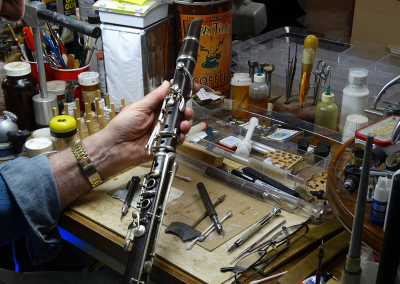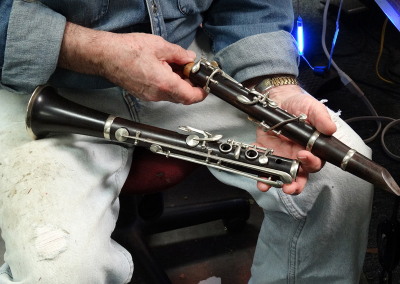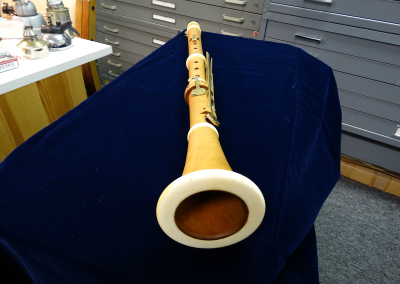Pro Overhaul $429| with one year warranty
- Tightening of loose keys (Swedging)
- Post Swedging
- Polishing and cleaning of keys + posts
- Degreasing and oiling of the hinges
- Full wood cleaning
- Logo re-guilding
- Tone hole resurfacing (1 max)
- Securing of loose posts (1 max)
- Free Nylon Inserts
- Spring replacement where needed (7 max)
- High-tech bumper materials
- Choice of pads – cork, leather, synthetic, or combination – same price
- Key height/tension adjustment
- Tenon cork replacement
- Voicing and moderate clarinet tuning
Click To Contact
Additional Services
- Key and Post Polishing
- Silver – Free
- Nickel (Machine-Polished) – $45
- Nickel (Hand-Polished) – $90
- Key and Post Replating – $299 (with Full Spring Replacement)
- Dual Layer Key Bumpers – $35
- Spring Modifications – $25
- Doctor’s Wood Treatment – $50
- Tonehole and Bore Polish – $25
- Cork Pad Beveling – $35
Artist Overhaul $579| with one year warranty
Includes everything in the Professional Overhaul plus:
- Dual Layer Key Bumpers
- Spring Modifications
- Doctor’s Wood Treatment
- Tone Hole and Bore Polish
- Cork Pad Beveling
Upgrades and Customizations
- Thumb Rest Relocation – $35
- Carbon Fiber Clarinet Pins – $30
- Clarinet Extensions – Bb, A, and Bass
Click To Contact
Additional Services
- Key and Post Polishing
- Silver – Free
- Nickel (Machine-Polished) – $45
- Nickel (Hand-Polished) – $90
- Key and Post Replating – $299 (with Full Spring Replacement)
- Dual Layer Key Bumpers – $35
- Spring Modifications – $25
THE CLARINET (WOOD, PLASTIC, METAL)
About twelve years ago a friend of mine, knowing my passion for restoring wood flutes, asked me if I could bring her fathers’ old Buffet pre R13 back to life. He had played the clarinet during his service in the U.S. Army band during the Korean War and it would mean a great deal to her if she could learn to play it. I hadn’t done any work on the clarinet and was a bit hesitant but she said there was no time frame for its completion; so I decided to fit it into my schedule.
I did some research on the origins of the clarinet and found it both fascinating and enlightening. Here is the Wikapedia brief history of the clarinet and its origins:
The clarinet is a family of woodwind instruments that have a single-reed mouthpiece, a straight cylindrical tube with an approximately cylindrical bore, and a flaring bell. A person who plays any type of clarinet is called a clarinetist or clarinettist.
The word clarinet may have entered the English language via the French clarinette (the feminine diminutive of Old French clarin or clarion), or from Provençal clarin, “oboe”.[1] It “is plainly a diminutive of clarino, the Italian for trumpet”, and the Italian clarinetto is the source of the name in many other languages. According to Johann Gottfried Walther, writing in 1732, the reason for the name is that “it sounded from far off not unlike a trumpet”. The English form clarinet is found as early as 1733, and the now-archaic clarionet appears from 1784 until the early years of the 20th century.[2]
There are some different types of clarinets of differing sizes and pitches. The unmodified word clarinet usually refers to the B♭ soprano clarinet, by far the most common type, which has a large range of nearly four octaves.[3] The clarinet family is the largest woodwind family, with more than a dozen types, ranging from the (extremely rare) BBB♭ octo-contrabass to the A♭ piccolo clarinet. Of these, many are rare or obsolete (there is only one BBB♭ octo-contrabass clarinet in existence, for example), and music written for them is usually played on more common versions of the instrument.
Johann Christoph Denner invented the clarinet in Germany around the turn of the 18th century by adding a register key to the earlier chalumeau. Over time, additional keywork and airtight pads were added to improve tone and playability.
Today, the clarinet is commonly used in classical music (such as concert bands, orchestras, chamber music, and solo repertoire), military bands, marching bands, klezmer, and jazz, as well as in folk music, Arabic pop, choro, samba, and Bulgarian wedding music.
I began working on my friend’s fathers’ Buffet and discovered that I thoroughly enjoyed the adventure. Disassembly was much more complex than the modern flute and the duplication of keys for alternate fingerings made a great deal of sense. Padding was very straightforward and I used (and still use) the classical method of floating the pads in on liquid shellac. I decided to pad the Buffet in the style that the classical French technicians had developed, using solid cork pads for the upper body section and traditional leather pads for the lower section. After disassembly of the key-work and loose body rings I thoroughly cleaned the wood and soaked the tuning barrel, upper and lower joints and bell in an organic solution of castor and Chinese Tung oil for 24 hours. I then thoroughly wiped dry the parts both externally and internally. The wood now glowed with a fine warmth that had been lost over the years of its neglect. I ultrasonically cleaned all the metal parts and replaced the cork bumpers and tenon corks with all natural sheet cork. Before re-padding I pre-assembled the keys and checked all the springs for proper tension and the height of the keys for venting. The next step was to float in all the pads. I disassembled the upper key-work and working from the register key down I seated all the cork pads. Next, I took the key-work off of the lower section and floated in the leather pads working from the bottom of the section upwards. I then air tested both sections for air-tightness, fit the upper and lower sections together and adjusted the play in the bridge for proper key alignment and seal. The bell and tuning barrel fit snugly on their respective tenons and low and behold my first clarinet was completed.
Since that day I have had the privilege of working on all types of clarinets. From a superb Firth, Hall and Pond, boxwood, Ivory and brass keyed 1810, simple system, key of C clarinet (pictured in the clarinet section of the web page) to Albert system, Boehm system and even some home-made instruments.
The modern Boehm Bb clarinet comes in several materials. The most popular is the dark wood of Grenadilla, with Rosewood and ironwood also being very desirable. The popularity of the clarinet in marching bands gave rise to the metal clarinet; usually made of brass or nickel silver and off-time silver plated, some were even made of sterling silver and all have a very piercing vocal quality. The most recent material to have gained popularity for the student is a plastic often called ebonite or resonite. It is very durable and has a pleasant warm quality to its tone.




